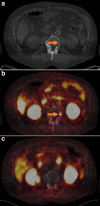Comparison of [(18)F]DCFPyL and [ (68)Ga]Ga-PSMA-HBED-CC for PSMA-PET Imaging in Patients with Relapsed Prostate Cancer
- PMID: 26013479
- PMCID: PMC4493776
- DOI: 10.1007/s11307-015-0866-0
Comparison of [(18)F]DCFPyL and [ (68)Ga]Ga-PSMA-HBED-CC for PSMA-PET Imaging in Patients with Relapsed Prostate Cancer
Abstract
Purpose: Gallium-68 (Ga-68)-labeled tracers for imaging expression of the prostate-specific membrane antigen (PSMA) such as the [(68)Ga]Ga-PSMA-HBED-CC have already demonstrated high potential for the detection of recurrent prostate cancer. However, compared to Ga-68, a labeling with fluorine-18 (F-18) would offer advantages with respect to availability, production amount, and image resolution. [(18)F]DCFPyL is a promising F-18-labeled candidate for PSMA-positron emission tomography (PET) imaging that has been recently introduced. In the current study, we aimed to compare [(68)Ga]Ga-PSMA-HBED-CC and [(18)F]DCFPyL for clinical use in biochemically relapsed prostate cancer.
Procedures: In 14 selected patients with PSA relapse of prostate cancer, [(18)F]DCFPyL PET/X-ray computed tomography (CT) was performed in addition to [(68)Ga]Ga-PSMA-HBED-CC PET/CT. A systematic comparison was carried out between results obtained with both tracers with regard to the number of detected PSMA-positive lesions, the standardized uptake value (SUV)max and the lesion to background ratios.
Results: All suspicious lesions identified by [(68)Ga]Ga-PSMA-HBED-CC were also detected with [(18)F]DCFPyL. In three patients, additional lesions were observed using [(18)F]DCFPyL PET/CT. The mean SUVmax in the concordant [(18)F]DCFPyL PSMA-positive lesions was significantly higher as compared to [(68)Ga]Ga-PSMA-HBED-CC (14.5 vs. 12.2, p = 0.028, n = 15). The mean tumor to background ratios (n = 15) were significantly higher for [(18)F]DCFPyL compared to [(68)Ga]Ga-PSMA-HBED-CC using kidney, spleen, or parotid as reference organs (p = 0.006, p = 0.002, p = 0.008), but no significant differences were found using the liver (p = 0.167) or the mediastinum (p = 0.363) as reference organs.
Conclusion: [(18)F]DCFPyL PET/CT provided a high image quality and visualized small prostate lesions with excellent sensitivity. [(18)F]DCFPyL represents a highly promising alternative to [(68)Ga]Ga-PSMA-HBED-CC for PSMA-PET/CT imaging in relapsed prostate cancer.
Figures





References
-
- Silver DA, Pellicer I, Fair WR, et al. Prostate-specific membrane antigen expression in normal and malignant human tissues. Clin Cancer Res. 1997;3:81–85. - PubMed
Publication types
MeSH terms
Substances
LinkOut - more resources
Full Text Sources
Other Literature Sources
Medical
Research Materials
Miscellaneous

